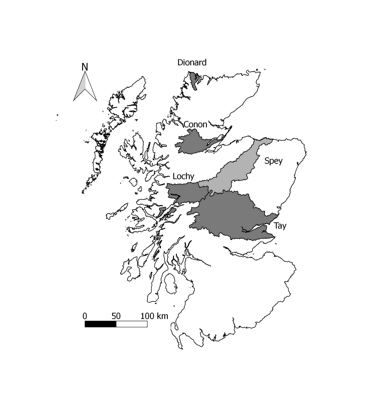Scottish Marine and Freshwater Science Vol 6 No 5: Ranching to the rod: an evaluation of adult returns from hatchery-reared Atlantic salmon smolts released in Scottish rivers
Report presents recapture data from monitored smolt releases on four Scottish rivers and
compares return rates of hatchery and wild-reared salmon smolts originating from a
common stock on two of these rivers. DOI: http://dx.doi.org/10.7489/1610-1
Materials and methods
Rod-caught recaptures from hatchery-reared smolts
Hatchery-reared smolts were released in four Scottish river catchments (Figure 1, Table 1) in the period 1987-2000. In all cases stocked smolts were the progeny of local-caught adult fish. On the Rivers Dionard, Conon and Tay, brood stock was collected annually, close to spawning, in late autumn. Crosses of mature fish were made randomly within groups, and the resultant offspring were reared in tanks. On the River Lochy, smolts were derived from brood stock of Lochy origin that had been bred in captivity for several generations (number unknown) by a commercial fish farm operator and were cage-reared. In all cases hatchery-reared smolts were fed a diet of commercial pelleted fish food.
Stocked smolts were selected on size (>100 mm) and evidence of smolting (silvering, blackening of fins). Using standard procedures, each fish was anaesthetised, tagged with a coded wire microtag (CWT) and adipose fin-clipped to aid recognition. The tagging process took place up to several weeks before the fish were stocked and stocking took place in spring (i.e. mid. April to mid. May). On the Rivers Lochy and Conon, smolts were released as one-year-olds (S1s), whereas those released on the Dionard and Tay comprised both S1 and two-year-old (S2) fish. As there were no significant differences in the recapture rates of S1s and S2s stocked in the Tay in the same years (Fishers exact test; p=0.404) the two categories have been combined. In years when S1s and S2s were both released in the Dionard , the recaptures generated were insufficient to allow comparisons ( Table 1). Tagged fish were transported and released at sites within or upstream of the main fishing beats, generally in the lower sections of the rivers ca. 5-15 km above the head of tide. In most cases, stocked smolts were released directly into rivers. The exceptions were those stocked in the River Dionard when in three of four years a proportion (unknown) of the stocked fish was held in release pens for a period prior to release.
Comparative smolt releases
Comparisons were made of wild and hatchery-reared smolts from the River Conon (2 years) and the River Tay (1 year). Hatchery smolts were batch-stocked as S1s on the Conon and as S2s on the Tay. Several days prior to release, stocked smolts were tagged with Passive Integrated Transponders ( PITs, Conon) or with CWTs (Tay). Wild-reared smolts were trapped as downstream migrants in a fixed trap (Conon) or in a modified Fyke net (Tay) and were tagged and released on the day of capture. Two release sites were used on the Conon: Conon Bridge (NH542560), close to the head of tide, and Torrachilty (NH448544), ca. 10 km upstream from the sea ( Table 2). The Tay release site was in the middle reaches of the River Braan tributary (NN939384) ca. 45 km from the sea ( Table 2). In both rivers the release of hatchery smolts was timed to coincide with the period of peak smolt migration for wild fish in April. Returns of tagged fish to the Conon were detected using an automatic PIT detection system located in a fish pass at Torrachilty Dam, below the point where the fish were reared. Returns to the Tay were from recaptures of tagged adult fish reported from commercial net and rod fisheries.
Recaptures of tagged fish
The tagging programmes were publicised widely within the river catchments used for smolt releases. As an incentive, a reward together with tagging information was offered to captors of tagged fish and posters with contact details were displayed in fishing huts and local tackle shops. In addition, on the Rivers Lochy, Dionard and Conon, daily inspections of catches were undertaken by trained ghillies on the main angling beats. Heads of fin-clipped fish were retained and tags later excised and decoded at the Freshwater Fisheries Laboratory, Pitlochry.
Recaptures were also reported from commercial coastal and river/estuary nets and reductions in coastal netting occurred over the course of the study. The Tay releases are therefore represented by two distinct periods. In the earlier period (1991-1994) nets accounted for the majority of reported recaptures (overall 41 compared with 5 rod-caught fish). From 1996-1998 declines in coastal netting and the cessation of a net and coble fishery that operated within the river in 1995, led to an increase in the percentage of rod-caught fish reported from the Tay (Fishers exact test; p< 0.001). A seasonal net and coble fishery also operated in the Conon estuary but reported no recaptured fish. There was no commercial netting in the lower reaches or estuaries of the Rivers Lochy and Dionard during the course of the study.
Figure 1. Map of Scotland showing salmon fishery districts with rivers used for smolt stocking experiments (dark shading). Also shown is the Spey salmon fishery district (light shading) where a study on the economic impact of salmon rod fisheries to the local economy was conducted in 2003 (Butler et. al. 2009).

Contact
There is a problem
Thanks for your feedback